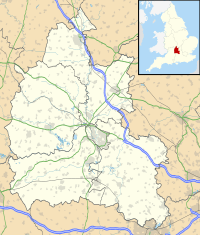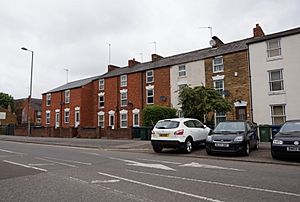Banbury Castle facts for kids
Quick facts for kids Banbury Castle |
|
|---|---|
| Banbury, Oxfordshire, England | |
| Coordinates | 52°03′46″N 1°20′05″W / 52.0628°N 1.3348°W |
| Type | Motte and bailey, later concentric pentagonal castle |
| Site information | |
| Condition | No remains |
| Site history | |
| Events | English Civil War |
Banbury Castle was a medieval castle located in the town of Banbury, Oxfordshire, England. It was a very important building in its time. Even though nothing of the castle remains today, historians know it was special because of its early "concentric" design. This means it had walls built in circles, one inside the other, for strong defense.
| Top - 0-9 A B C D E F G H I J K L M N O P Q R S T U V W X Y Z |
History of Banbury Castle
Building the First Castle
Banbury Castle was first built in 1135. It was ordered by Alexander, who was the Bishop of Lincoln. The first castle was a "motte and bailey" design. This means it had a large earth mound (the motte) with a wooden tower on top. Below the motte was a walled courtyard (the bailey).
Just a few years later, in 1139, King Stephen took the castle from Bishop Alexander. But the bishop got it back later that same year. For many years, the castle mostly stayed in the hands of the bishops until 1547. People from nearby lands, called a "castle-guard," helped protect it.
A Stronger, Rounder Castle
Between 1201 and 1207, during the time of King John, the castle was made even stronger. Later, between 1225 and 1250, the castle was completely rebuilt. The new design was very modern for its time. It had a "concentric" shape, meaning it had thick walls built in a pentagon (five-sided) shape, with other walls inside. This made it very hard to attack.
Historians like John Kenyon say Banbury Castle was "remarkable" for its early concentric design. Castles like Harlech and Beaumaris, which are famous for this design, were built much later. The castle also had a gatehouse, which was the main entrance. By the late 1200s, the bishops of Lincoln were using the castle as a prison.
New Owners and a Prison for Catholics
In 1547, a powerful person named Edward Seymour, the Duke of Somerset, bought the castle. Soon after, it went to John Dudley, the Duke of Northumberland. He then sold it to the King or Queen (the Crown) in 1551.
After this, the prison inside the castle became smaller. By the 1560s, it had almost disappeared. However, in the 1580s, the prison was used again. It held "recusants," who were Roman Catholics. They refused to attend the Church of England services, which was against the law at the time. In 1595, the castle was leased to Richard Fiennes, who was the lord of Saye and Sele.
Banbury Castle and the English Civil War
The English Civil War began in 1642. This was a big fight between the Royalist supporters of King Charles I and the supporters of Parliament.
- First Siege (1642): Banbury Castle was first held by William Fiennes, who supported Parliament. The castle was quickly made stronger for defense. After a big battle nearby called Edgehill, King Charles marched south. He forced the castle to surrender and took its 1,500 firearms.
- Second Siege (1644): The Royalists now held the castle. In 1644, Parliamentary forces, led by William Fiennes, attacked it again. The Royalist governor, a young 18-year-old named William Compton, bravely defended the castle from July to October. His brother, James, arrived and helped break the siege. In November, King Charles I even had dinner at the castle!
- Third Siege (1646): In January 1646, Sir Edward Whalley and 3,000 men attacked the castle again. The Royalist side was losing the war. In May, Compton and his 300 men had to surrender.
After the war ended, in 1648, the castle was "slighted." This means it was deliberately torn down. This was done to stop anyone from using it as a fort again. William Fiennes was paid £2,000 by Parliament for the damage. Stones from the castle were later used to build houses in Banbury town.
Today
Today, you cannot see any parts of Banbury Castle. Its exact location is now marked by a road called Castle Street. Archaeologists (people who study old things) dug up the site in 1973 and 1974 to learn more about the castle.



